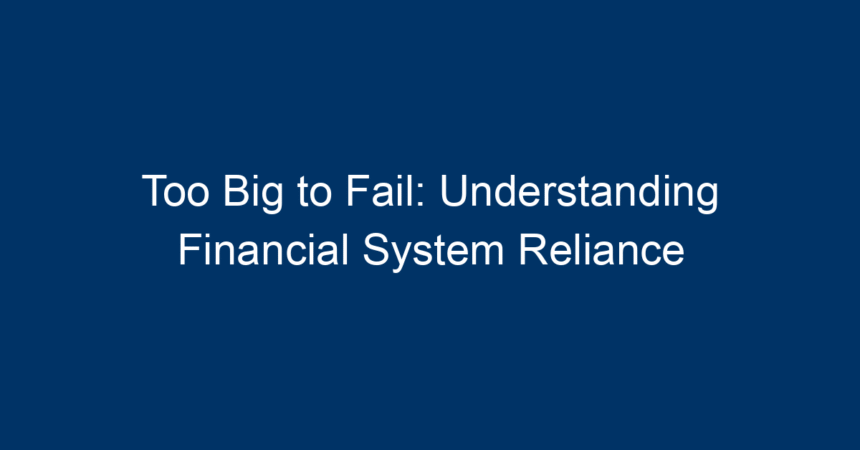Introduction
In the world of finance, the expression "too big to fail" has come to signify much more than just the daunting size of certain institutions. It embodies the concept that some financial entities wield such significant influence over the economy that their collapse would spell disaster for the global financial system. Understanding the nuances of this concept is crucial for policymakers, investors, and everyday citizens alike. In this article, we will explore the implications of being "too big to fail," its historical context, the risks associated, and the potential strategies for mitigating these risks.
The Origins of "Too Big to Fail"
The term "too big to fail" emerged prominently during the 2008 financial crisis. As financial markets crashed and major institutions like Lehman Brothers collapsed, it became clear that certain banks and corporations had become so intertwined with the economy that their failure would lead to catastrophic consequences. This led to unprecedented government interventions, including bailouts funded by taxpayer dollars, aimed at preventing a total collapse.
Historical Context
- The S&L Crisis of the Late 1980s: Prior instances of financial distress, such as the Savings and Loan crisis, hinted at the consequences of large institutions failing.
- The 2008 Financial Crisis: The collapse of Lehman Brothers served as the quintessential example, raising questions about the systemic risks posed by large financial institutions.
The historical backdrop offers valuable insights into why certain firms are deemed "too big to fail" and the significant implications that follow.
The Mechanics of Being "Too Big to Fail"
1. Definition and Identification
What exactly qualifies a bank or corporation as "too big to fail"? The answer lies in several interrelated factors:
-
Size and Market Share: Institutions with substantial market presence can influence market conditions directly. For instance, if a major bank were to collapse, it could induce panic and a liquidity crisis among other banks.
-
Interconnectedness: The financial web is intricate; institutions share assets, liabilities, and dependencies. The more interconnected a firm is, the greater the systemic risk it poses.
- Government Support: Some institutions have implicit government backing, leading to a perception (and sometimes reality) that they will receive assistance in a crisis.
2. Implications of Being "Too Big to Fail"
The implications can be divided into several categories:
-
Market Distortion: When certain firms receive bailouts, it creates an uneven playing field; smaller companies may struggle in the absence of similar safety nets.
-
Moral Hazard: If institutions know they will be rescued in a crisis, they may take excessive risks, believing they can do so without facing the consequences.
- Public Trust: Bailing out large banks can erode public confidence in the economic system, leading to a distrust in financial institutions and government.
The Risks Associated with "Too Big to Fail"
Understanding the risks is crucial for stakeholders, from policymakers to everyday investors.
1. Financial Instability
The interconnected nature of the global financial system means that the failure of one institution can lead to a cascading effect. This phenomenon was vividly illustrated in 2008, raising questions about the overall stability of financial markets.
2. Regulatory Challenges
Regulating large institutions poses specific challenges:
-
Compliance Costs: Enforcing regulations can strain resources and create a burden for compliance.
- Dynamic Markets: Financial products and services are continually evolving, making static regulations increasingly ineffective.
3. Economic Inequality
The focus on bailing out big institutions often comes at the expense of small businesses and citizens, exacerbating economic inequality. With resources directed toward corporate bailouts, average individuals may feel neglected.
Mitigating the Risks
While the notion of being "too big to fail" poses significant risks, several strategies can contribute to mitigating these dangers.
1. Strengthening Regulatory Frameworks
Enhanced regulatory frameworks can help ensure that large institutions do not pose systemic risks:
-
Stress Testing: Regular stress tests can identify vulnerabilities.
- Capital Buffers: Requiring banks to hold more capital can cushion against losses in a downturn.
2. Implementing Resolution Plans
Also known as "living wills," resolution plans outline how to wind down a failing institution without disrupting the broader economy. Mandating these plans can help manage failures more effectively.
3. Promoting Financial Literacy
Empowering individuals with financial knowledge can reduce reliance on large institutions and encourage responsible investment practices.
Conclusion: The Future of "Too Big to Fail"
As we navigate an increasingly complex financial landscape, the challenge of managing "too big to fail" institutions remains ever-present. While the implications of such entities are multi-faceted and challenging, proactive measures—combined with increased awareness—can pave the way for a more stable financial future.
Actionable Insights
-
Stay Informed: Monitor updates on financial regulations and major institutional shifts.
-
Diversify Investments: Reduce risk by spreading investments across a range of asset classes.
-
Advocate for Transparency: Support policies that promote transparency in financial institutions, fostering greater public trust.
- Enhance Financial Knowledge: Engage in continuous learning about financial markets, risks, and investment strategies.
By understanding the risks associated with "too big to fail," we can better prepare ourselves for future challenges and contribute to a healthier financial system.




